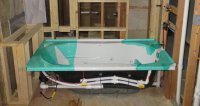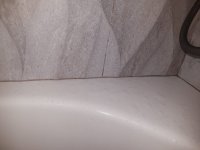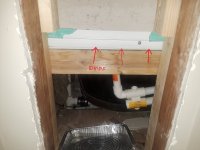Giantsean
Member
Hi All,
I had these question and pics as part of an older thread, but investigating the problem more I found I had a lot more questions than might be contained there, hence a new one.
We have a drop in whirlpool tub in an alcove configuration which has a flange around three sides. This setup has developed a leak that we thought was originally from the plumbing (it was, but there's more). In the process of fixing that issue, we found a lot more water coming out from the back sides of the tub flanges through the wall.
My question is, are these meant to be fully waterproof from the factory? Originally I had thought this was the case, but perhaps they are simply riveted on and make a press seal at best, allowing them to flex over time and letting water escape. Had this problem existed at the rate it leaks now for the two years it's been installed, I doubt there would be a floor left for the tub to sit on.
The water is leaking through the edge of the flange where the tile meets the tub. At the time our tile guy told us we could just grout it because it has a flange, but it's looking more likely that this should have been caulked from minute one, and that the grout had done it's best but eventually gave way to cracking. Which makes me also ask, if water can just drip down any time, and was meant to be caulked, what's the point of the flange in the first place? It's not like it does a fabulous job holding the tub to the wall. Is it just for keeping huge volumes of water from splashing over? Seems like a kind of suspect design overall, and I'd probably opt for a molded flange next time for sure.
Any thoughts appreciated!
I had these question and pics as part of an older thread, but investigating the problem more I found I had a lot more questions than might be contained there, hence a new one.
We have a drop in whirlpool tub in an alcove configuration which has a flange around three sides. This setup has developed a leak that we thought was originally from the plumbing (it was, but there's more). In the process of fixing that issue, we found a lot more water coming out from the back sides of the tub flanges through the wall.
My question is, are these meant to be fully waterproof from the factory? Originally I had thought this was the case, but perhaps they are simply riveted on and make a press seal at best, allowing them to flex over time and letting water escape. Had this problem existed at the rate it leaks now for the two years it's been installed, I doubt there would be a floor left for the tub to sit on.
The water is leaking through the edge of the flange where the tile meets the tub. At the time our tile guy told us we could just grout it because it has a flange, but it's looking more likely that this should have been caulked from minute one, and that the grout had done it's best but eventually gave way to cracking. Which makes me also ask, if water can just drip down any time, and was meant to be caulked, what's the point of the flange in the first place? It's not like it does a fabulous job holding the tub to the wall. Is it just for keeping huge volumes of water from splashing over? Seems like a kind of suspect design overall, and I'd probably opt for a molded flange next time for sure.
Any thoughts appreciated!



